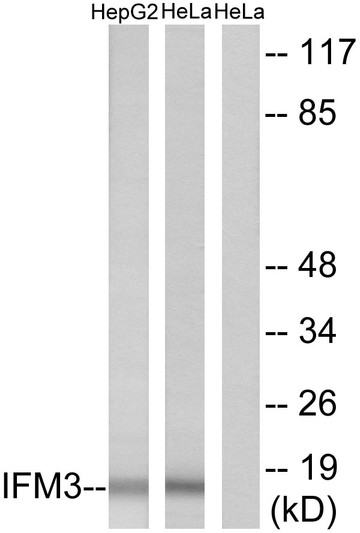| Function | IFN-induced antiviral protein which disrupts intracellular cholesterol homeostasis. Inhibits the entry of viruses to the host cell cytoplasm by preventing viral fusion with cholesterol depleted endosomes. May inactivate new enveloped viruses which buds out of the infected cell, by letting them go out with a cholesterol depleted membrane. Active against multiple viruses, including influenza A virus, SARS coronaviruses (SARS-CoV and SARS-CoV-2), Marburg virus (MARV), Ebola virus (EBOV), Dengue virus (DNV), West Nile virus (WNV), human immunodeficiency virus type 1 (HIV-1), hepatitis C virus (HCV) and vesicular stomatitis virus (VSV). Can inhibit: influenza virus hemagglutinin protein-mediated viral entry, MARV and EBOV GP1,2-mediated viral entry, SARS-CoV and SARS-CoV-2 S protein-mediated viral entry and VSV G protein-mediated viral entry. Plays a critical role in the structural stability and function of vacuolar ATPase (v-ATPase). Establishes physical contact with the v-ATPase of endosomes which is critical for proper clathrin localization and is also required for the function of the v-ATPase to lower the pH in phagocytic endosomes thus establishing an antiviral state. In hepatocytes, IFITM proteins act in a coordinated manner to restrict HCV infection by targeting the endocytosed HCV virion for lysosomal degradation. IFITM2 and IFITM3 display anti-HCV activity that may complement the anti-HCV activity of IFITM1 by inhibiting the late stages of HCV entry, possibly in a coordinated manner by trapping the virion in the endosomal pathway and targeting it for degradation at the lysosome. Exerts opposing activities on SARS-CoV-2, including amphipathicity-dependent restriction of virus at endosomes and amphipathicity-independent enhancement of infection at the plasma membrane. |
| Protein Name | Interferon-Induced Transmembrane Protein 3Dispanin Subfamily A Member 2bDspa2bInterferon-Inducible Protein 1-8u |
| Database Links | Reactome: R-HSA-909733 |
| Cellular Localisation | Cell MembraneSingle-Pass Type Ii Membrane ProteinLate Endosome MembraneEarly Endosome MembraneLysosome MembraneCytoplasmPerinuclear RegionCo-Localizes With Bri3 Isoform 1 At The Perinuclear Region |
| Alternative Antibody Names | Anti-Interferon-Induced Transmembrane Protein 3 antibodyAnti-Dispanin Subfamily A Member 2b antibodyAnti-Dspa2b antibodyAnti-Interferon-Inducible Protein 1-8u antibodyAnti-IFITM3 antibody |
Information sourced from Uniprot.org










![Immunofluorescence analysis of U-2 OS cells using [KO Validated] IFITM3 Rabbit polyclonal antibody (STJ115037) at dilution of 1:100. Secondary antibody: Cy3 Goat Anti-Rabbit IgG (H+L) at 1:500 dilution. Blue: DAPI for nuclear staining. Immunofluorescence analysis of U-2 OS cells using [KO Validated] IFITM3 Rabbit polyclonal antibody (STJ115037) at dilution of 1:100. Secondary antibody: Cy3 Goat Anti-Rabbit IgG (H+L) at 1:500 dilution. Blue: DAPI for nuclear staining.](https://cdn11.bigcommerce.com/s-zso2xnchw9/images/stencil/600x533/products/94077/375456/STJ115037_1__41009.1713142223.jpg?c=1)
